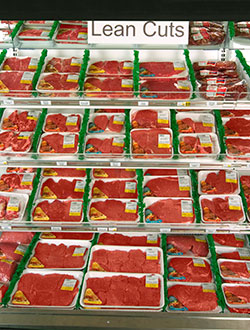 Like milk, beef has a unique combination of nutrients that support a healthy body. Beef is surprisingly lean. Over time, cattle have become more efficient in feed conversion and are not finished to the excessive heavier weights of decades ago. Today, all lean beef cuts have less than 10 grams of total fat in a 3.5-ounce cooked serving. That 3-ounce portion is just shy of half of a person's daily protein needs.
Like milk, beef has a unique combination of nutrients that support a healthy body. Beef is surprisingly lean. Over time, cattle have become more efficient in feed conversion and are not finished to the excessive heavier weights of decades ago. Today, all lean beef cuts have less than 10 grams of total fat in a 3.5-ounce cooked serving. That 3-ounce portion is just shy of half of a person's daily protein needs.The majority of food you purchase at the grocery store contains a label, and beef is no different. It details the kind of meat, the wholesale cut and the name of the cut. The individual portion also contains the package weight, price per pound, the total price, the sell-by date and safe handling instructions. It may also contain food preparation instructions. For ground beef, it contains the percent of lean beef and the corresponding fat portion, such as 20 percent fat/80 percent lean or 7 percent fat/93 percent lean.
If you are shopping for beef, select product with a bright cherry-red color, keeping in mind that sealed bags have a darker purplish-red color, as the air will turn beef a brighter red. Beef that is firm to the touch is preferred.
Once you have selected a package, inspect it for any rips or tears and be sure it is cold. Do not purchase beef with excessive liquid in the package. All of these will alter its shelf-life . . . so be observant of the printed sell-by date. Purchase your beef on or before the sell-by date, and plan to use it within one to two days after purchase.
After making your purchase, try to get it home within 30 minutes. If it will take longer, consider a cooler in your vehicle to keep the temperature cool. If it will not be eaten within a day or two, it can be frozen for two weeks in its original packaging.
If you plan to keep it frozen longer, it should be placed in a freezer bag or wrapped in aluminum foil.
And, once your meal is on the table, be sure to refrigerate any leftovers within two hours after cooking.

The author is the online media manager and is responsible for the website, webinars and social media. A graduate of Modesto Junior College and Fresno State, she was raised on a California dairy and frequently blogs on youth programs and consumer issues.








